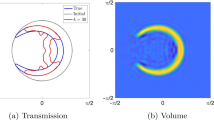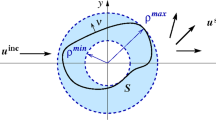Abstract
In this paper, we investigate inverse obstacle scattering problems in acoustic waveguides with low-frequency data. A Bayesian inference scheme, combining a multi-fidelity strategy and surrogate model with guided modes and a deep neural network is proposed to reconstruct the shapes of unknown scattering objects. First, the inverse problem is reformulated as a statistical inference problem using Bayes’ formula, which provides statistical characteristics of the posterior distribution and quantification of the uncertainties. The well-posedness of the posterior distribution is proved by using the f-divergence. Subsequently, a Markov Chain Monte Carlo algorithm is used to explore the posterior density. We propose a new multi-fidelity surrogate model to accelerate the sampling procedure while maintaining high accuracy. Our numerical simulations demonstrate that this method not only produces high-quality reconstructions but also substantially reduces computational costs.















Similar content being viewed by others
Data Availability
This is a piece of fundamental research and no data were analyzed or generated.
References
Baggeroer, A.B., Kuperman, W.A., Mikhalevsky, P.N.: An overview of matched field methods in ocean acoustics. IEEE J. Ocean. Eng. 18(4), 401–424 (1993)
Dhia, A.S.B.B., Dakhia, G., Hazard, C., Chorfi, L.: Diffraction by a defect in an open waveguide: a mathematical analysis based on a modal radiation condition. SIAM J. Appl. Math. 70(3), 677–693 (2009)
Snyder, A.W., Love, J.D., et al.: Optical Waveguide Theory, vol. 175. Chapman and Hall, London (1983)
Bourgeois, L., Lunéville, E.: The linear sampling method in a waveguide: a modal formulation. Inverse Probl. 24(1), 015018 (2008)
Borcea, L., Meng, S.: Factorization method versus migration imaging in a waveguide. Inverse Probl. 35(12), 124006 (2019)
Arens, T., Gintides, D., Lechleiter, A.: Direct and inverse medium scattering in a three-dimensional homogeneous planar waveguide. SIAM J. Appl. Math. 71(3), 753–772 (2011)
Bourgeois, L., Lunéville, E.: On the use of the linear sampling method to identify cracks in elastic waveguides. Inverse Probl. 29(2), 025017 (2013)
Monk, P., Selgas, V.: Sampling type methods for an inverse waveguide problem. Inverse Probl. Imaging 6(4), 709–747 (2012)
Borcea, L., Nguyen, D.L.: Imaging with electromagnetic waves in terminating waveguides (2015). arXiv preprint arXiv:1510.07062
Meng, S.: A sampling type method in an electromagnetic waveguide. Inverse Probl. Imaging 15(4), 745–762 (2021)
Bourgeois, L., Le Louër, F., Lunéville, É.: On the use of lamb modes in the linear sampling method for elastic waveguides. Inverse Probl. 27(5), 055001 (2011)
Bourgeois, L., Lunéville, E.: On the use of the linear sampling method to identify cracks in elastic waveguides. Inverse Probl. 29(2), 025017 (2013)
Bourgeois, L., Fliss, S.: On the identification of defects in a periodic waveguide from far field data. Inverse Probl. 30(9), 095004 (2014)
Chen, J., Huang, G.: A direct imaging method for inverse electromagnetic scattering problem in rectangular waveguide. Commun. Comput. Phys. 23(5), 1415–1433 (2018)
Li, M., Zhang, R.: Near-field imaging of sound-soft obstacles in periodic waveguides. Inverse Probl. Imaging 11, 6 (2017)
Zhang, R.: Spectrum decomposition of translation operators in periodic waveguide. SIAM J. Appl. Math. 81(1), 233–257 (2021)
Zhang, R., Sun, J.: The reconstruction of obstacles in a waveguide using finite elements. J. Comput. Math. 36(1), 29–46 (2018)
Stuart, A.M.: Inverse problems: a bayesian perspective. Acta Numer 19, 451–559 (2010)
Kaipio, J., Somersalo, E.: Statistical and Computational Inverse Problems, vol. 160. Springer, Berlin (2006)
Li, Z., Deng, Z., Sun, J.: Extended-sampling-bayesian method for limited aperture inverse scattering problems. SIAM J. Imag. Sci. 13(1), 422–444 (2020)
Li, Z., Liu, Y., Sun, J., Liwei, X.: Quality-bayesian approach to inverse acoustic source problems with partial data. SIAM J. Sci. Comput. 43(2), A1062–A1080 (2021)
Yang, Z., Gui, X., Ming, J., Hu, G.: Bayesian approach to inverse time-harmonic acoustic scattering with phaseless far-field data. Inverse Probl. 36(6), 065012 (2020)
Yang, Z., Gui, X., Ming, J., Hu, G.: Bayesian approach to inverse time-harmonic acoustic obstacle scattering with phaseless data generated by point source waves. Comput. Methods Appl. Mech. Eng. 386, 114073 (2021)
Huang, J., Deng, Z., Xu, L.: A bayesian level set method for an inverse medium scattering problem in acoustics. Inverse Probl. Imaging 15, 5 (2021)
Liu, Y., Guo, Y., Sun, J.: A deterministic-statistical approach to reconstruct moving sources using sparse partial data. Inverse Probl. 37(6), 065005 (2021)
Yin, Y., Yin, W., Meng, P., Liu, H.: On a hybrid approach for recovering multiple obstacles. Commun. Comput. Phys. 31(3), 869–892 (2022)
Yin, Y., Yin, W., Meng, P., Liu, H.: The interior inverse scattering problem for a two-layered cavity using the bayesian method. Inverse Probl. Imaging 16, 673–690 (2022)
Bui-Thanh, T., Ghattas, O.: An analysis of infinite dimensional bayesian inverse shape acoustic scattering and its numerical approximation. SIAM/ASA J. Uncertain. Quant. 2(1), 203–222 (2014)
Colton, D., Kress, R.: Inverse Acoustic and Electromagnetic Scattering Theory, vol. 93. Springer, Berlin (2019)
Sun, J.: Local estimators and bayesian inverse problems with non-unique solutions. Appl. Math. Lett. 132, 108149 (2022)
Kirsch, A., et al.: An Introduction to the Mathematical Theory of Inverse Problems, vol. 120. Springer, Berlin (2011)
Mishra, S., Ochsner, D., Ruf, A.M., Weber, F.: Well-posedness of bayesian inverse problems for hyperbolic conservation laws (2021). arXiv preprint arXiv:2107.09701
Hosseini, B., Nigam, N.: Well-posed bayesian inverse problems: priors with exponential tails. SIAM/ASA J. Uncertain. Quant. 5(1), 436–465 (2017)
Latz, J.: On the well-posedness of bayesian inverse problems. SIAM/ASA J. Uncertain. Quant. 8(1), 451–482 (2020)
Sprungk, B.: On the local lipschitz stability of bayesian inverse problems. Inverse Probl. 36(5), 055015 (2020)
Yan, L., Zhou, T.: Adaptive multi-fidelity polynomial chaos approach to bayesian inference in inverse problems. J. Comput. Phys. 381, 110–128 (2019)
Yan, L., Zhou, T.: An adaptive surrogate modeling based on deep neural networks for large-scale bayesian inverse problems. Commun. Comput. Phys. 28(5), 2180–2205 (2020)
Jia, J., Zhao, Q., Zongben, X., Meng, D., Leung, Y.: Variational bayes’ method for functions with applications to some inverse problems. SIAM J. Sci. Comput. 43(1), A355–A383 (2021)
Jia, J., Li, P., Meng, D.: Stein variational gradient descent on infinite-dimensional space and applications to statistical inverse problems. SIAM J. Numer. Anal. 60(4), 2225–2252 (2022)
Villa, U., Petra, N., Ghattas, O.: Hippylib: an extensible software framework for large-scale inverse problems governed by PDES: part I: deterministic inversion and linearized bayesian inference. ACM Trans. Math. Softw. 47(2), 1–34 (2021)
Jin, B.: Fast bayesian approach for parameter estimation. Int. J. Numer. Methods Eng. 76(2), 230–252 (2008)
Peherstorfer, B., Willcox, K., Gunzburger, M.: Survey of multifidelity methods in uncertainty propagation, inference, and optimization. SIAM Rev. 60(3), 550–591 (2018)
Lehtinen, M.S., Paivarinta, L., Somersalo, E.: Linear inverse problems for generalised random variables. Inverse Probl. 5(4), 599 (1989)
Bui-Thanh, T., Ghattas, O.: Analysis of the hessian for inverse scattering problems: I. Inverse shape scattering of acoustic waves. Inverse Probl. 28(5), 055001 (2012)
Hastings, W.K.: Monte carlo sampling methods using Markov chains and their applications (1970)
Metropolis, N., Ulam, S.: The Monte Carlo method. J. Am. Stat. Assoc. 44(247), 335–341 (1949)
Guo, L.: Sparse approximation of data-driven polynomial chaos expansions: an induced sampling approach. Commun. Math. Res. 36, 2 (2020)
Gao, Yu., Liu, H., Wang, X., Zhang, K.: On an artificial neural network for inverse scattering problems. J. Comput. Phys. 448, 110771 (2022)
Kingma, D.P., Adam, J.B.: A method for stochastic optimization (2014). arXiv preprint arXiv:1412.6980
Christen, J.A., Fox, C.: Markov Chain Monte Carlo using an approximation. J. Comput. Graph. Stat. 14(4), 795–810 (2005)
Efendiev, Y., Datta-Gupta, A., Ginting, V., Ma, X., Mallick, B.: An efficient two-stage Markov Chain Monte Carlo method for dynamic data integration. Water Resour. Res. 41, 12 (2005)
Efendiev, Y., Hou, T., Luo, W.: Preconditioning Markov Chain Monte Carlo simulations using coarse-scale models. SIAM J. Sci. Comput. 28(2), 776–803 (2006)
Ginting, V., Pereira, F., Presho, M., Wo, S.: Application of the two-stage Markov Chain Monte Carlo method for characterization of fractured reservoirs using a surrogate flow model. Comput. Geosci. 15, 691–707 (2011)
Hoang, V.H., Schwab, C., Stuart, A.M.: Complexity analysis of accelerated MCMC methods for bayesian inversion. Inverse Probl. 29(8), 085010 (2013)
Stuart, G.K., Minkoff, S.E., Pereira, F.: A two-stage Markov Chain Monte Carlo method for seismic inversion and uncertainty quantification. Geophysics 84(6), R1003–R1020 (2019)
Madrigal-Cianci, J.P., Nobile, F., Tempone, R.: Analysis of a class of multilevel Markov Chain Monte Carlo algorithms based on independent metropolis-hastings. SIAM ASA J. Uncertain. Quant. 11(1), 91–138 (2023)
Dodwell, T.J., Ketelsen, C., Scheichl, R., Teckentrup, A.L.: A hierarchical multilevel Markov Chain Monte Carlo algorithm with applications to uncertainty quantification in subsurface flow. SIAM ASA J. Uncertain. Quant. 3(1), 1075–1108 (2015)
Acknowledgements
We would like to thank all the anonymous reviewers for their valuable comments and suggestions. The work of Y. Gao was supported by the Graduate InnovationFund of Jilin University. The work of H. Liu was supported by the Hong Kong RGC General Research Funds, 12302017, 12301218, 12302919 and ANR/RGC Joint Research Fund, A-HKBU203/19. The work of X. Wang was supported by the NSFC Grants (12001140 and 11971133) and the Fundamental Research Funds for the Central Universities (FRFCU5710050422 and 2022FRFK060026). The work of K. Zhang was supported by the NSF of China under the grant No. 12271207, and by the fundamental research funds for the central universities.
Author information
Authors and Affiliations
Corresponding authors
Ethics declarations
Conflict of interest
The authors declare that they have no conflict of interest.
Additional information
Publisher's Note
Springer Nature remains neutral with regard to jurisdictional claims in published maps and institutional affiliations.
Appendices
Appendix A
Theorem 6.1
(Fernique Theorem, theorem 6.9 in [18]) If \(\mu = N(0, C)\) is a Gaussian measure on some Banach space Z, so that \(\mu (Z) = 1\), then there is a \(\varepsilon \)> 0 such that
Appendix B
For the sake of convenience, let \(\displaystyle \pi _1(\varvec{z})=\frac{d\mu _1}{d\mu _0}\) and \(\displaystyle \pi _2(\varvec{z})=\frac{d\mu _2}{d\mu _0}\) be the Radon–Nikodym derivatives of \(\mu _1\) and \(\mu _2\) with respect to \(\mu _0\), respectively.
Appendix C
Rights and permissions
Springer Nature or its licensor (e.g. a society or other partner) holds exclusive rights to this article under a publishing agreement with the author(s) or other rightsholder(s); author self-archiving of the accepted manuscript version of this article is solely governed by the terms of such publishing agreement and applicable law.
About this article
Cite this article
Gao, Y., Liu, H., Wang, X. et al. A Bayesian Scheme for Reconstructing Obstacles in Acoustic Waveguides. J Sci Comput 97, 53 (2023). https://doi.org/10.1007/s10915-023-02368-2
Received:
Revised:
Accepted:
Published:
DOI: https://doi.org/10.1007/s10915-023-02368-2





